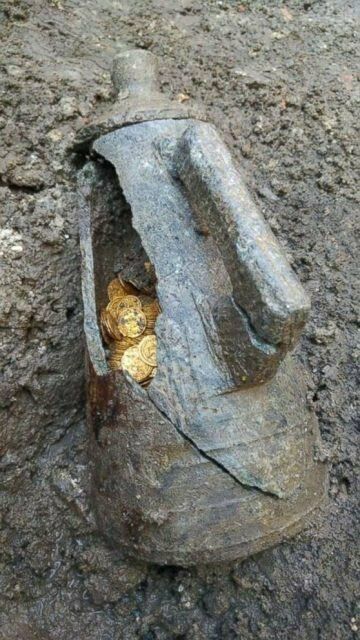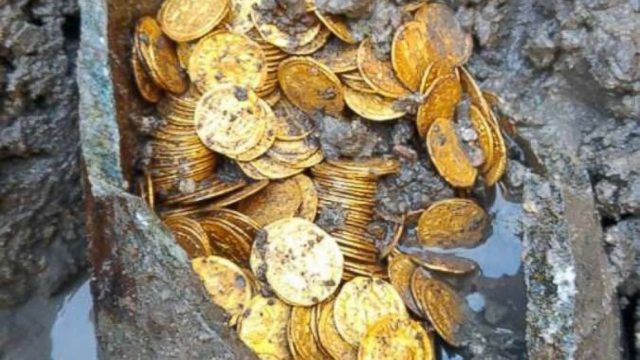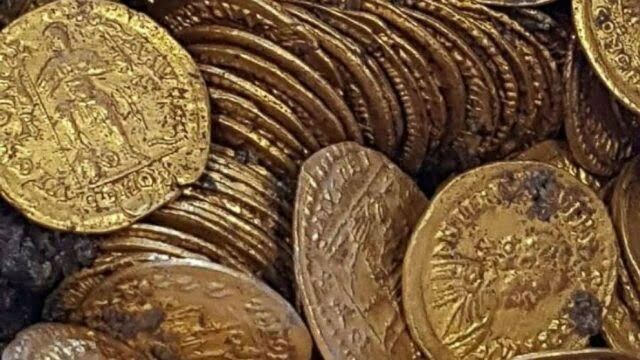Stunning Discovery: Italy Unearths Hundreds of Ancient Roman Coins Crafted in Pure Gold
Workers frantically searched through what they initially believed to be a large soapstone container, only to discover that it was an amphora filled to the brim with Roman gold coins. These coins, dating back to the 4th or 5th century, were uncovered during an archaeological excavation in Como, Italy. The unexpected nature of the discovery surprised experts, as amphorae were typically used to store wine and foodstuffs for the Romans.
According to NPR.org, the Roman coins feature images of emperors such as Honorius, Valentinian III, Leo I, Anthemius, and Libius Severus, all predating 474 AD. The depiction of these emperors will contribute to correcting any misconceptions about their appearance, while also enabling scientists to gain a deeper understanding of this tumultuous period in Italy’s history.
The exact value of the hundreds of coins remains uncertain. Coin expert Maria Grazia Facchinetti speculates that the cache may not have belonged to a common citizen but perhaps to a public bank. Alternatively, given the looming threat of Germanic invaders in Italy at the time, it is plausible that a wealthy individual or group may have hidden the gold for safekeeping.
The current plan is to leave the amphora in its original position and extract twenty-seven representative coins for examination at Milan’s Mibac restoration laboratory. Only after conducting a proper archaeological excavation will the work proceed further to determine if anything else lies beneath the building.
The Teatro Cressoni, where the coins were discovered, is situated not far from the ancient city of Novum Comum, which houses numerous other significant Roman artifacts. The theater, originally constructed in 1870, had various purposes throughout its history, serving as a residential home and cinema before being abandoned in 1997. Its renovation aimed to transform the building into apartments, as reported by Newsweek.com.
Culture Minister Alberto Bonisoli expressed pride in this remarkable find. Comocopia.com informs us that Como was originally an old Roman settlement known as Novum Comum, founded by Julius Caesar in 59 BC. The Roman presence endured for the next six hundred years, with the town boasting nearly forty thousand residents by the 3rd century BC.
The remains of the over twenty-six-foot-tall wall erected by Caesar’s legions are still visible, as are the remnants of the Porta Pretoria, a double-arched gateway that welcomes visitors. The town likely possessed temples dedicated to the gods, artisan workshops, houses, a forum, and a theater. Outside the walls, one would find a bathhouse, cemetery, and luxurious villas. The Paolo Giovio Archaeological Museum, housed within Palazzo Giovio, showcases various local Roman artifacts, including paintings, mosaics, marble reliefs, frescoes, statues, and relics from prehistoric times to the present.
Pliny the Younger, a renowned Roman historian who documented the eruption of Mount Vesuvius that devastated Pompeii, hailed from Como and spoke fondly of the town and the nearby lake.
Coinsweekly.com reports that a gold bar was discovered in the same location as the three hundred coins and was also taken to Milan for examination. The coins were found in exceptional condition, each weighing four grams of pure gold. However, the value of the find can vary depending on the likeness of the emperor depicted, as coins from the reign of Valentinian III hold greater worth than those from the reign of Libius Severus.
Once the coins and amphora have been fully excavated and examined, they will likely be returned to Como and displayed at the Paolo Giovio Archaeological Museum.
Hits: 1






